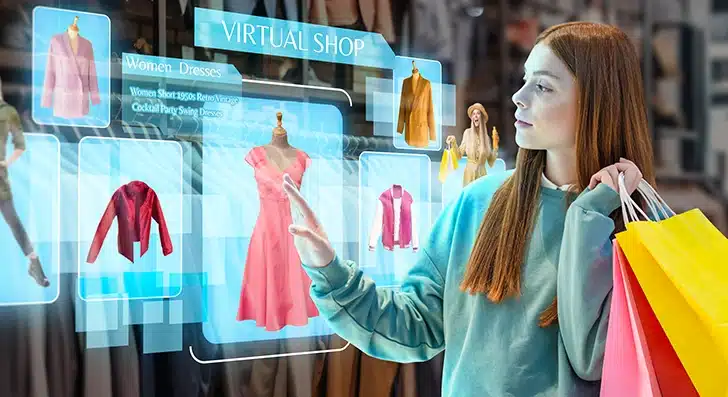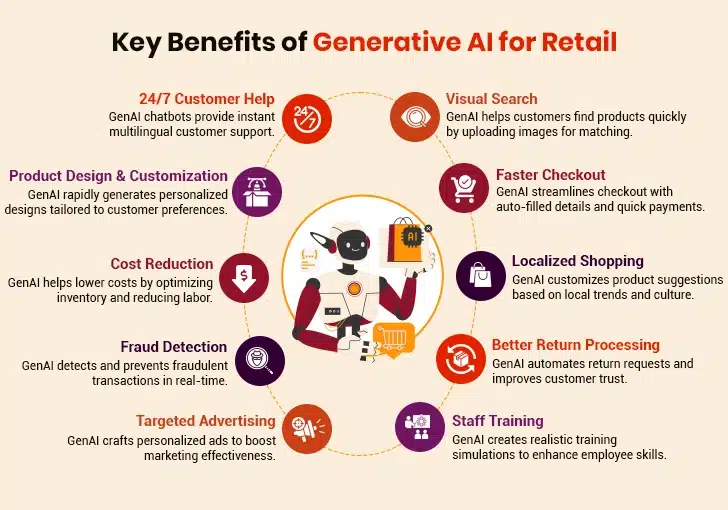Generative AI emerges as a technological marvel in the bustling landscape of modern retail, redefining the very essence of shopping experiences in ways previously unimaginable. In fact, 39% have used Gen AI for online shopping, according to a recent report published by Adobe. What’s more interesting to note is that Gen AI will have an impact of 9.2 trillion USD on retail businesses through 2029, according to a new forecast by IHL Group. This may be one of the reasons why a staggering 98% of retailers are planning to invest in this disruptive technology in the next one and a half years (1.5 years), according to a survey report conducted by the World Leader in Artificial Intelligence Computing, NVIDIA. Now, let’s dive into this detailed piece to explore the use cases of GenAI in retail. The post also delves into the key benefits, real-life applications, and challenges and considerations of Generative AI in retail. Now, let’s dive into this detailed piece to explore the use cases of GenAI in retail. The post also delves into the key benefits, real-life applications, and challenges and considerations of Generative AI in retail.
Redefine Retail Possibilities with Generative AI Use Cases
Retail is changing fast, and generative AI is leading this shift. It helps stores create better shopping experiences without extra effort. From personalized suggestions to smart inventory management, AI makes everything smoother. These use cases show how any retailer, big or small, can benefit.
1. Personalized Product Recommendations
Generative AI has emerged as a game-changer in crafting personalized product recommendations by analyzing large volumes of data encompassing browsing behaviors, past purchases, demographic information, and even contextual cues. This enhances the shopping experience of customers by offering them products that closely resonate with their preferences, increasing the likelihood of conversions.
Generative AI algorithms continuously learn and adapt as individual preferences evolve over time, refining its recommendations to meet changing customer demands. This results in immersive shopping experiences where customers feel valued, fostering loyalty and engagement, and driving long-term value. Furthermore, Generative AI allows retailers to create cohesive and omnichannel experiences by delivering personalized recommendations at scale across various touchpoints, including mobile applications, websites, email campaigns, and even physical stores.
2. Virtual Try-on
Another groundbreaking application of Generative AI in retail is virtual try-on, offering customers a more realistic representation of products before making purchase decisions. By leveraging augmented reality (AR) technologies and advanced computer vision, Gen AI algorithms allow customers to virtually try on items such as footwear, apparel, makeup, eyewear, and accessories in real-time via digital platforms. In short, virtual try-on experiences powered by Generative AI not only eliminate the need for returns but also augment customer confidence in buying decisions, which in turn, drive conversion rates in an increasingly digital-first retail landscape.
3. Automated Content Generation
Generative AI in retail can streamline automated content generation for diverse marketing collaterals, ranging from email newsletters and social media posts to product descriptions and blog posts. This automated content generation powered by Generative AI not only resonates with customers but also helps retailers effectively communicate with their audience, improve brand perception, and accelerate business growth in the digital realm. Furthermore, Generative AI can dynamically adapt content based on expansive factors such as marketing objectives, seasonal trends, and audience demographics, enabling retailers to deliver targeted and personalized messaging at scale. The best part is that Generative AI algorithms can mimic the tonality, style, and voice of a brand, ensuring authenticity and consistency across all communication channels.
4. Inventory Management and Demand Forecasting
By ingesting and analyzing large volumes of historical sales data, consumer behavior patterns, market trends, and external factors like economic indicators, Generative AI in the retail industry can anticipate fluctuations in demand with precision. This proactive approach empowers retailers to avoid overstock situations, minimize the risk of stockouts, and optimize inventory levels, which in turn, leads to improved supply chain efficiency and reduced costs associated with excess inventory. In a nutshell, leveraging the potential of Generative AI for inventory management and demand forecasting can help retailers improve customer satisfaction, achieve greater operational efficiency, and drive sustainable growth in a rapidly evolving retail landscape.
5. Dynamic Pricing
Dynamic pricing represents a groundbreaking strategy of Gen AI in retail that revolutionizes real-time price optimization in response to consumer behaviors and market conditions. Generative AI algorithms can analyze an array of data sources, including consumer demand, competitor pricing, historical sales data, seasonality, and even individual customer preferences, to dynamically adjust prices. This allows retailers to optimize pricing strategies to maximize revenue potential while maintaining competitiveness in the market. Besides this, Generative AI in retail facilitates agile decision-making by providing real-time insights into changing market dynamics and consumer preferences, enabling retailers to respond quickly to emerging trends and capitalize on opportunities.
The Impact of Generative AI in Transforming Customer Experience
Key Benefits of Generative AI for Retail
Generative AI in retail offers a multitude of benefits. This may include quick customer support, fraud detection, faster checkout, and more. Let’s explore them in detail.
I. 24/7 Customer Help
Generative AI allows retailers to provide instant customer support through chatbots. These tools help with order tracking, returns, and product information. This means customers get instant help without waiting.
Explore How GenAI Helps in Customer Support:
- Responds faster to customer queries
- Handles order status and return requests automatically
- Reduces pressure on human support teams
- Gives quick answers to common questions
- Supports multiple languages for global customers
- Learns from past interactions to improve responses
II. Product Design and Customization
Generative AI can come up with new designs based on customer needs. Faster design processes mean stores can launch new products quickly. This makes shopping more engaging and increases customer satisfaction.
Here are Simple Ways GenAI Helps in Product Design:
- Generates multiple design options in seconds
- Customizes products with names or special messages
- Helps create limited-edition collections faster
- Reduces time spent on manual design work
- Allows customers to personalize items before buying
- Adapts designs based on trending customer preferences
III. Cost Reduction
Generative AI helps retailers reduce costs through task automation. This leads to increased efficiency and lower expenses while maintaining quality service. Lower costs also allow retailers to offer better prices or invest in other improvements.
Let’s Find Out How GenAI Helps in Cost Reduction:
- Automates routine customer service through chatbots
- Optimizes inventory levels to prevent overstocking
- Lowers labor costs in stores and warehouses
- Minimizes pricing errors with smart algorithms
- Cuts down on wasted resources through better planning
IV. Fraud Detection
GenAI spots suspicious transactions by recognizing unusual patterns. It flags potential credit card fraud or fake returns immediately, protecting both retailers and customers. This prevents losses from scams and theft.
Discover the Role of GenAI in Fraud Detection:
- Flags unusual purchases in real-time
- Stops stolen credit card transactions
- Reduces fake returns and chargebacks
- Learns new fraud patterns over time
- Protects customer data from breaches
- Saves money lost to scams
V. Targeted Advertising
GenAI creates customized ads for different customer groups. A college student sees different messaging than a parent for the same product. This makes marketing more personalized and effective.
Here’s How GenAI Helps in Targeted Advertising:
- Suggests products based on browsing history
- Writes engaging ad copies and emails
- Personalizes discounts for different shoppers
- Generates social media content quickly
- Places ads on the right platforms for better reach
- Tests different versions of ad copies for better results
- Increases conversion rates with relevant offers
VI. Visual Search
Customers can upload images to find similar products instantly. GenAI scans pictures and matches them with items in stock, making shopping faster and easier.
Here’s How GenAI Helps Customers with Visual Searches:
- Allows shoppers to search using photos instead of text
- Helps when customers don’t know product names
- Finds matching or similar products quickly
- Works for fashion, furniture, and decor
- Reduces time spent searching manually
- Improves discovery of new products
VII. Faster Checkout
GenAI speeds up checkout by remembering customer details and suggesting quick payment options. This reduces cart abandonment and makes buying effortless. Faster checkouts mean happier customers and more sales.
Explore How GenAI Helps in Faster Checkout:
- Minimizes typing errors in forms
- Cuts down waiting time in queues
- Auto-fills shipping and payment details
- Reduces steps in the checkout process
- Offers one-click purchase options
- Supports digital wallets for quick payments
VIII. Localized Shopping
GenAI adjusts product offerings based on location. A store in Florida might show more swimsuits while one in Minnesota shows winter coats. This makes suggestions more useful for local customers.
Understanding How GenAI Helps in Localized Shopping:
- Shows products popular in the shopper’s area
- Recommends items based on regional trends
- Displays prices in local currency
- Respects cultural preferences in suggestions
- Translates product details into local languages
- Offers location-specific discounts
IX. Better Return Processing
GenAI automates return requests by verifying purchase details and generating labels instantly. This speeds up refunds and improves customer trust. GenAI also helps retailers spot common issues to reduce future returns.
Discover How GenAI Helps in Better Return Processing:
- Checks eligibility for returns automatically
- Generates return shipping labels quickly
- Tracks returned items in real-time
- Speeds up refunds for approved requests
- Reduces manual work for staff
- Makes the process hassle-free for customers
X. Staff Training
GenAI creates realistic training simulations for retail employees, helping them learn faster. It provides instant feedback and improves customer service skills.
Here’s How GenAI Helps in Staff Training:
- Simulates real customer interactions for practice
- Offers quick tips during training sessions
- Adapts lessons based on employee progress
- Reduces training time for new hires
- Improves handling of difficult situations
- Ensures consistent knowledge across staff
Real-Life Applications of Generative AI in the Retail Industry
Explore the given table showcasing real-world applications of Generative AI for retail. These real-life examples help you understand how to make shopping easier, faster, and more personal.
| GenAI Real-World Applications | Examples | How It Helps |
|---|---|---|
| Shopping Assistant | eBay ShopBot (a GenAI chatbot that helps users discover products) | Makes searching easier, simply describe what you need, and it finds matching items. |
| Better Return Processing | Zara’s automated return system | Generates return labels instantly after scanning the receipt, speeding up refunds. |
| Fraud Detection | Amazon’s GenAI-powered fraud prevention | Blocks fake orders and stolen credit card use before they cause losses. |
| 24/7 Customer Help | H&M’s GenAI chatbot on their website | Answers customer questions about sizes, returns, and stock availability anytime. |
| Faster Checkout | Walmart’s Scan & Go feature | Customers scan items with their phone and pay instantly, skipping checkout lines. |
| Localized Shopping | McDonald’s GenAI menu boards | Shows different meal suggestions based on weather, time of day, and location. |
| Automated Content Generation | Shopify Magic (a GenAI tool that automatically writes product descriptions) | Saves time for store owners by creating clear, unique descriptions quickly. |
| Virtual Try-On | Sephora Virtual Artist (Lets customers try makeup looks using phone camera) | Helps customers see how makeup looks before buying, reducing returns. |
The Transformative Impact of Generative AI on the Future of Business
Challenges and Considerations of Generative AI in Retail
a) Bias and Fairness: Similar to other AI systems, Gen AI models are prone to inheriting biases present in the training datasets, which can lead to discriminatory decisions or biased recommendations. This may pose significant reputational and ethical risks for retailers since biased AI algorithms can undermine trust, leading to customer dissatisfaction, reputational damage, and legal risks. To mitigate bias and promote fairness, retailers need to regularly audit AI models and adopt rigorous bias detection and mitigation techniques throughout the AI development lifecycle to ensure fairness and equity in decision-making processes.
b) Integration with Existing Systems: Integrating Generative AI in retail may present a multifaceted challenge since retailers operate complex ecosystems comprising legacy systems, IT infrastructures, and business processes, each with its own set of requirements and dependencies. Retailers must assess compatibility and interoperability between Generative AI and existing retail systems to ensure smooth data flow and communication between systems. Additionally, retailers must navigate technical complexities such as security protocols and data compatibility requirements to ensure successful adoption and deployment.
c) Regulatory Compliance: With the proliferation of consumer protection rights, data privacy laws, and industry-specific guidelines, it becomes challenging for retailers to stay abreast of ever-evolving regulatory landscapes. Retailers must consider industry-specific regulations that may govern Gen AI usage, such as GDPR, CCPA, and more. To mitigate legal risks and safeguard consumer trust, retailers can adopt transparency measures and implement robust data governance practices, fostering a secure and compliant environment for the deployment of Gen AI in retail.
Summing Up
Generative AI in retail is truly revolutionary since it not only transcends conventional boundaries but also bridges the gap between online and offline experiences, engaging customers in unprecedented ways. However, as retailers embark on this transformative journey that redefines every facet of the shopping experience, they must confront challenges such as bias mitigation, integration complexities, and regulatory compliance to leverage the full potential of this disruptive technology. If you also want to harness the power of Gen AI in retail to craft immersive shopping experiences that captivate and engage customers, you may seek help from a Generative AI services provider.







